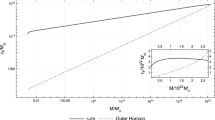Abstract
The dynamics of a charged relativistic particle in electromagnetic field of a rotating magnetized celestial body with the magnetic axis inclined to the axis of rotation is studied. The covariant Lagrangian function in the rotating reference frame is found. Effective potential energy is defined on the base of the first integral of motion. The structure of the equipotential surfaces for a relativistic charged particle is studied and depicted for different values of the dipole moment. It is shown that there are trapping regions for the particles of definite energies.


















Similar content being viewed by others
References
Alfven, H.: In: Cosmical Electrodynamics. International Series of Monographs on Physics. Clarendon, Oxford (1950)
Babcock, H.W., Cowling, T.G.: Mon. Not. R. Astron. Soc. 113, 356 (1953)
Belinsky, V., Ruffini, R.: Astrophys. J. 401, L27 (1992)
Belinsky, V., De Paolis, F., Lee, H.W., Ruffini, R.: Astron. Astrophys. 283, 1018 (1994)
Beskin, V.S., Istomin, Ya.N., Philippov, A.A.: Phys. Usp. 56, 164 (2013)
Deutsch, A.J.: Ann. Astrophys. 18, 1 (1955)
DeVogelaere, R.: In: Lefschetz, S. (ed.) Contributions to the Theory of Nonlinear Oscillations, pp. 53–84. Princeton University Press, Princeton (1958)
Dragt, A.J.: Rev. Geophys. 3(2), 255 (1965)
Epp, V., Masterova, M.A.: Astrophys. Space Sci. 345, 315 (2013)
Ferrari, A., Trussoni, E.: Astrophys. Space Sci. 24, 3 (1973)
Ferrari, A., Trussoni, E.: Astrophys. Space Sci. 33, 111 (1975)
Finkbeiner, B., Ertl, T., Herold, H., Ruder, H.: Mitt. Astron. Ges. 70, 375 (1987)
Georgiou, A.: Il Nuovo Cimento B 123(2), 201 (2008)
Goldreich, P., Julian, W.J.: Astrophys. J. 157, 869 (1969)
Holmes-Siedle, A.G., Adams, L.: Handbook of Radiation Effects. Oxford University, Oxford (2002)
Istomin, Ya.N., Sobyanin, D.N.: J. Exp. Theor. Phys. 109, 393 (2009)
Jackson, E.A.: Astrophys. J. 206, 831 (1976)
Kaburaki, O.: Astrophys. Space Sci. 67, 3 (1980)
Katsiaris, G.A., Psillakis, Z.M.: Astrophys. Space Sci. 126, 69 (1986)
Landau, L.D., Lifshitz, E.M.: The Classical Theory of Fields, 4th edn. Pergamon, New York (1975)
Laue, H., Theilheim, K.O.: Astrophys. J. Suppl. Ser. 61, 465 (1986)
Michel, F.C.: Theory of Neutron Star Magnetospheres. University of Chicago Press, Chicago (1991)
Rezzolla, L., Ahmedov, B.J., Miller, J.C.: Mon. Not. R. Astron. Soc. 322, 723 (2001)
Rezzolla, L., Ahmedov, B.J., Miller, J.C.: Radiophys. Quantum Electron. 52, 900 (2009)
Størmer, C.: Arch. Sci. Phys. Nat. 24, 5 (1907)
Størmer, C.: The Polar Aurora. Clarendon, Oxford (1955)
Thielheim, K.O., Wolfsteller, H.: Astrophys. J. Suppl. Ser. 71, 583 (1989)
Timofeev, V.B., Timofeeva, T.E.: Prog. Electromagn. Res. Lett. 45, 19 (2014)
Acknowledgements
This research has been supported by the grant for LRSS, project No. 88.2014.2.
Author information
Authors and Affiliations
Corresponding author
Appendix: Stationary points of the relativistic potential energy
Appendix: Stationary points of the relativistic potential energy
The power of potential formulation of the problem is the possibility to find the “potential valleys” where the charged particles can be trapped. And the slope of the “valley” shows the force exerted on the particle. Having this in mind, we find the stationary points of the potential energy, i.e. the points satisfying the set of equations:
where q i =ρ,θ,ψ. This gives a system of three equations
Equation (A.3) has two solutions:
Solution (i)
The stationary points on the axis θ=0,π can exist provided that ∂V/∂ρ=0 and ∂V/∂θ=0 for any ψ, which is not the case as one can see in Eqs. (A.1)–(A.2). As to the equatorial plane \(\theta=\frac{\pi}{2}\), Eqs. (A.1)–(A.2) have the next solutions:
Coordinate ρ in Eq. (A.6) increases monotone as N∥ increases, and asymptotically approaches the value of unity as N∥→∞. For small N∥ it takes the value \(\rho \approx N_{\parallel}^{1/3}\).
Solution (ii)
Substituting η=0,π into Eqs. (A.1) and (A.2) we obtain two equations for ρ and θ of the stationary points:
where ε=1 for η=0 and ε=−1 for η=π. Solution of these equations gives the lines at which the stationary points are lying
and equation for coordinate ρ at these lines:
where \(Q=3\cot\alpha+q\sqrt{9\cot^{2}\alpha+8+4\rho^{2}}\) and q=±1 is the sign of the particle charge. If N≪1 and ρ≪1 these equations transform to Eqs. (36) and (37) of Paper I. The lines given by Eq. (A.9) are plotted in Fig. 7 for α=π/3.
Rights and permissions
About this article
Cite this article
Epp, V., Masterova, M.A. Effective potential energy for relativistic particles in the field of inclined rotating magnetized sphere. Astrophys Space Sci 353, 473–483 (2014). https://doi.org/10.1007/s10509-014-2066-9
Received:
Accepted:
Published:
Issue Date:
DOI: https://doi.org/10.1007/s10509-014-2066-9




